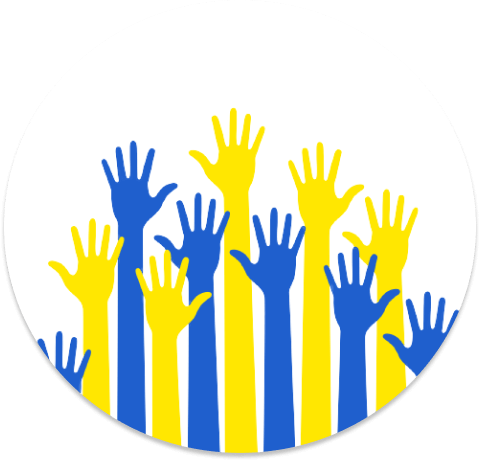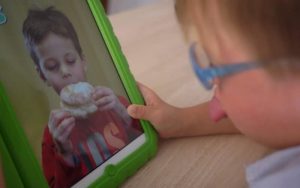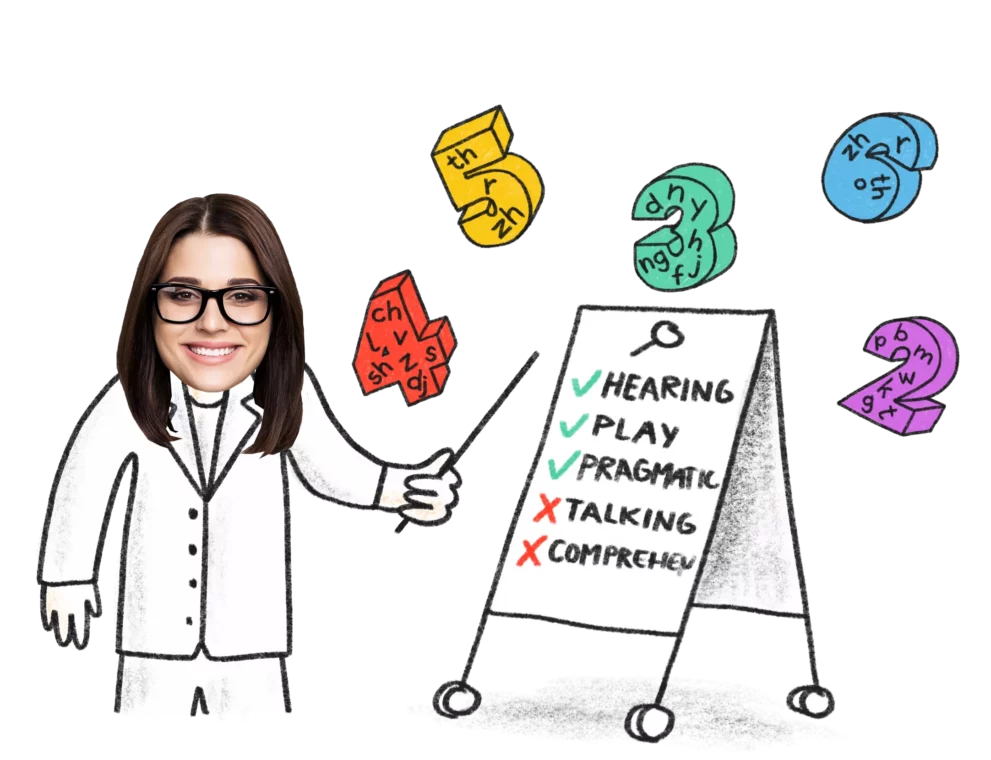The Latest Research on Down Syndrome Children and Speech
Feb 8, 2022 Down Syndrome is one of the most common chromosomal disorders and occurs due to random error during cell division resulting in an extra copy of the 21st pair of chromosomes.
This syndrome’s scientific name is ‘chromosome trisomy’; the extra genetic material results in the production of extra proteins which then interfere with the natural processes of the body. Delayed speech and language development are one of the few effects of interferences of a child with Down syndrome.
In This Article
On the spectrum of Down syndrome, the effect on kids can range from mild to severe. Keeping variability and individual differences in mind, four connected factors come together to cause delays in speech and language development.
Four Factors
- Facial profile construction: In Down syndrome, people typically have smaller mouths and noses and have a relatively large tongue. This creates less room for speech, and so their speech is less clear as air has difficulty moving through the oral and nasal cavities. Their palates are also narrow, arched, and raised higher than normal, which means they need more complex fine-motor effort and ability.
- Hearing: Ears are lower in position with Down syndrome kids. This can potentially cause otitis media; it’s when fluid gets stuck in the middle ear and results in stuffiness, pain, ear infection, and even hearing loss. The loss can be temporary or permanent and range from mild to profound [1].
- Muscle Tone: Tone is defined by how muscles respond to gravity at rest [2]. Typically, there is enough muscle tone to keep the mouth shut at rest [2].In Down syndrome, low muscle tone results in the opening of the mouth, lowered tongue posture, and mouth breathing. Consequently, with decreased muscle tone, strength, coordination, and a limited range of motion, we can expect some speed reduction in speech [1,3]. Low muscle tone and a high arched palate make sounds like /k/ and /g/ difficult as they require the raising of the tongue to the back of the palate (velum).
- Cognitive development: Most individuals with Down syndrome have moderate intellectual ability. While some cases may be severe, some have average cognitive capacities [1]. Repetition is essential to learn new skills and words. Though cognitive abilities may be already delayed, speech and language development usually lag behind cognitive development [4]. And so, people with Down syndrome know more than they can express. Performance does not always mirror competence.
Prelinguistic Communication
Speech development is a building block of learning. Each preliminary milestone serves as a basis for the more complex ones that are to come. Skills that must be developed before speech happens are called ‘prelinguistic (non-verbal) skills,’ and are acquired in two stages of communication:
- Pre-intentional Communication: Pre-intentional communication is any behavior that happens without clear intent to send a message to the caregiver. These include crying, facial expressions, reaching, etc.
- Intentional communication (8-10 months): Children at this stage reach a cognitive level where they realize that certain behaviors can be used as social cues to relay specific messages to caregivers.
Examples
Examples of intentional behaviors include pointing, responding to pointing, gestures, signs, eye-contact, and joint attention between an object and listener. Consistent vocalization also develops. Later in this stage, babies are even able to participate in give-and-take interactions involving eye-contact, vocalization, turn-taking, and pauses indicating waiting for a response.
Early communication is meant to direct the listener’s attention or to ask for something [5]. Pointing (6-10 months), and responding to names, emotional intonation, and words (3-6 months) are indicative of a progression towards the intentional communication stage. Most children with Down syndrome develop good prelinguistic skills; they perform intentional behaviors and use early gestures effectively [6].
Speech Milestones and Delays in Down Syndrome
Language development in Down syndrome occurs in the same order as typically developing children, just at slower rates. Speech delays become apparent when babbling and vocalization emerge.
Typical speech acquisition stages of Down syndrome:
- Reduplicative babbling: Begins at 9 months, with a 2-month delay. Reduplicative babbling is the repetition of a syllable consisting of a consonant and a vowel. Example: “ba-ba-ba-ba.”
- 10-word stage: Begins at 2.25 years with a 1.25-year delay.
- Vocabulary spurt: This sudden vocabulary explosion occurs at 2.5 years when children have an average vocabulary of 24 words[6]. It’s important to know that not every child will experience a vocabulary spurt; some expand their vocabulary consistently over a longer period.
- Two-word phrase consolidation: This stage occurs at 3-years-of-age, with an 18-month delay. Children enter this stage with an average vocabulary of 50-55 words [6].
(Bonamy et al., 1994)
Try Not to Worry
Note that these acquisition stages are based on an average basis. We must account for individual differences. Children progress at different rates. First words can appear as early as 1-year-old, or even as late as 5. While some children may say as little as 50 words at 3-years-old, some can say as much as 300 words. Every child is unique. Nonetheless, production will continue to develop.
Specific Speech and Language Challenges in Down Syndrome
Phonological Errors [6]:
Consonants can be hard to produce. Phonological errors are the simplification or modification of certain sounds to facilitate pronunciation. All children experience this as they explore the properties of sounds in speech production. Examples of phonological errors include:
| Truck | “Guck” | Consonant Cluster Reduction |
| Banana | “Nana” | Weak syllable Deletion |
| Toad | “Toa” | Final Consonant Deletion |
| Suck | ”Tuck” | Substitution- Stopping |
| Grey | “Gwey” | Substitution-Glidin |
| Car | “Ka” | Final Consonant Deletion |
Children with down syndrome typically use simplification patterns for longer periods to cope with poor speech intelligibility stemming from the construction of articulators and weakened voice quality. Phonological errors are used as a systematic process to make speech easier and to accelerate the speed of articulation.
Vocabulary
Children and adolescents understand spoken words at almost comparable levels as typically developing children of the same mental age. Receptive vocabulary is more advanced than expressive vocabulary in Down syndrome, hence the delays in first words. They know more words that refer to people and objects (nouns) compared to descriptive and action words (adjectives and verbs). Nonetheless, the meanings of a useful range of vocabulary can be steadily learned over time [6].
Syntax [6]
Syntax deals with the arrangement of words to create grammatical phrases and sentences. It appears to be a particular linguistic challenge for individuals with down syndrome in both expressive and receptive domains [2]. This means that both production and comprehension are challenged when connecting words to form a sentence. Consequently, arranging words is put at higher risk when comprehension is not established.
Children with Down syndrome show difficulties with:
Prepositions
Prepositions tell us information about time, place, and location; and it also links verbs, nouns, and pronouns in sentences.
Example: “of,” “in,” “by,” “at,” “over”
Bound Morphemes
Bound morphemes are the smallest unit of language that carries meaning. They give us information about tense, plural, person agreement, and possession. Example: -ed past tense, -s plural, -s third person singular agreement, -ing present progressive tense, and the apostrophe -‘s.
Active voice vs. Passive voice:
Active voice: “Sam chased the dog.”
Passive voice: “The dog was chased by the dog.”
Active sentences are easier to understand because the structure and action are linear. In English, it’s subject, verb, object.
On the other hand, the passive voice requires finer tuning of comprehension in Down syndrome, because the structure follows a reversed and non-linear order of action.
Direct vs. indirect object: Active sentences can be difficult when both direct and indirect objects are presented.
“He gave Katie (indirect object) a present (direct object).”
Moreover, introducing the passive voice in a sentence that has both direct and indirect objects can spark greater confusion. Keeping the real meaning of a sentence can be hard as either object can move around in the sentence structure:
Active: “He gave Katie (indirect object) a present (direct object).”
Passive:
“A present was given to Katie.”
“Katie was given a present.”
Modals
Modals suggest ability, possibility, permission, advice, and obligation.
Example: can, could, may, should, must.
Having difficulty putting together grammatical sentences results in saying shorter and basic responses. Children make themselves understood by putting keywords together. For example, they may say “Me go school bus” rather than “I go to school on the bus” [6]. Nonetheless, complex grammar and sentence structures can continue to be learned throughout adolescent years until early adulthood.
Verbal short-term Memory:
This type of memory helps us to organize expressive speech, process, and recall what we say and hear. Verbal short-term memory also plays an important role in word learning.
Pragmatic (Conversational skills):
Due to all the challenges mentioned above, children with down syndrome start conversations less often, and they are less descriptive. Simple responses are expected, and they are not very likely to ask for clarification [1].
Nevertheless, they can stay on conversational topics, respond to requests for clarifications, and can be attentive during storytelling with enough visual help such as pictures, toys, gestures, etc.
What Can I Do to Help My Child at Home?
Visual learning is a relative strength for children with Down syndrome, meaning, they learn better by seeing than hearing [6]. They are able to use signs, gestures, and visuals to communicate much sooner; as early as 10 months!
A Multi-sensory Approach
Current research mentions a strategy called the ‘Total Communication Approach.’ It’s a multi-sensory approach that combines auditory modalities with visual and tactile modalities [8]. It involves speaking while signing keywords, showing visual pictures, and touching objects.
Being able to see and hear what is being said simultaneously supports learning. Visual processing as a strength accelerates comprehension and production of spoken words, and provides an additional method of communication [9].
More on the Total Communication Approach
The Total Communication Approach is also known to increase the intelligibility of spontaneous speech. Children that are conditioned to sign keywords are expected to have higher speech intelligibility ratings than those that do not [8]. The benefits of this approach are proven to continue in adulthood.
You can help your child reach major language milestones by providing them with a language-rich environment of speech and visuals. But it’s important to remember that repetition is key, and children learn best by doing what they like. Below are a few strategies that you can implement in your daily interactions to improve your child’s vocabulary, syntax, and pragmatics.
Vocabulary:
Consistently teach and sign meaningful keywords while speaking.
Example: Sign object and action words like ball, car, baby, jump, baby, eat, etc.
Get the child’s attention by pointing and naming objects in your environment.
Example: Pictures in books and characters or objects on TV
Be highly responsive and less directive [9]. If your child points your attention to “ball,” you might respond “yes, it’s a bouncy ball.”
Encourage the child to play with push-button toys that refer to distinctive images through speech.
Sing songs with your child. Use pauses effectively to allow filling in and participation.
Syntax (adhering words to make grammatical sentences):
Integrate toys that encourage role-playing, such as a doctor, cooking, cleaning, and house toy kits.
Use common phrases frequently with signs: “do you want to go to the park,” “see you tomorrow,” “have a goodnight’s sleep,” or “do you want to play?” etc.
Implement participatory games like Simon Says and songs like “If you’re happy and you know it.” It serves as a template for grammatical sentences and creativity, while the child anticipates for instruction or action.
Pragmatics:
Encourage the child to say “hello,” “hi,” or “goodbye” while waving.
Teach your child the skill of imitation. This will in turn teach them to imitate sounds of speech.
Example: Peek-A-Boo.
Broaden the child’s social circle to stimulate social context.
Example: Go to the park, and visit friends and grandparents.
Describe emotions and feelings through facial miming.
Role-playing as previously mentioned will also improve social communication.
Note: SpeechBlubs is a voice-controlled speech therapy app with lots of fun expert-approved activities guaranteed to improve your child’s overall language abilities.
Available Professional Help for Your Child
Speech-Language Pathologists: Diagnose, assess, and improve speech and swallowing difficulties deriving from cognitive disorders, strokes, and physical misconstructions.
Audiologists: Conduct regular hearing tests for seasonal or permanent hearing loss. Based on a diagnosis, tools such as hearing aids and ear tubes can be recommended as needed.
Otolaryngologists/ENTs: Diagnose any problem relating to the ear, nose, and throat. They can also suggest the removal of tonsils and adenoids to create more space in the throat for easier breathing and speech.
Orthodontists: Correct and reconstruct misalignments of the teeth, jaw, and mouth. They’re also able to recommend tools such as palatal expanders to create space in the mouth for speech and breathing.
Myofunctional Therapists: Specialize in strengthening tone by correcting the resting posture of the oral cavity for nose breathing, and swallowing.
References:
Martin, G. E., Klusek, J., Estigarribia, B., & Roberts, J. E. (2009). Language Characteristics of Individuals with Down Syndrome. Top Lang Disord, 112–132.
DSRFCANADA (Director). (2020). Causes of Speech Challenges in People with Down Syndrome [Motion Picture].
Roberts, J., Long, S., Malkin, C., Barnes, E., Skinner, M., & Hennon, E. A. (2005). A Comparison of Phonological Skills of boys with Fragile X Syndrome and Down Syndrome. J Speech Lang Hear Res., 980–995.
Saxton, M. (2017). Child Language Acquisition and Development. London: SAGE Publications Ltd.
Language Development for Children with Down Syndrome. (2020). Retrieved from Down Syndrome Education International.
More References
Bonamy, O., & Buckley, S. (1994, June). The Language Development of Children with Down’s Syndrome: First Words to Two-word Phrases. Retrieved from Research Gate.
Hung, M., Truong, V., Wong, K., & Helms-Park, R. (2019). How Children Cope with the Pronunciation of Words. Toronto, Ontario, Canada.
Powell, G., & Clibbens, J. (1994). Actions Speak Louder than Words: Signing and Speech Intelligibility in Adults with Down Syndrome. The Down Syndrome Educational Trust Down Syndrome Research and Practice, 127–129.
Boston’s Children Hospital. (n.d.). Early Communication Development & Down Syndrome. Retrieved from Childrenshospital.org
Keep in Mind
While this blog is not comprehensive, it is a good starting point on the latest research on a Down syndrome child’s speech and language issues, as well as the benefits of early intervention and its influence on health problems.
Speech Blubs App Helps Your Child Catch up!
Make sure to download the Speech Blubs app: available in App Store, Google Play Store, and on our website! Work on imitation and articulation skills, build vocabulary to express needs, and converse more! Set your personalised goals now and start learning.
Speech Blubs is a learning app for everyone: If you want to work on language development or your child has a speech delay, autism, Down syndrome, hearing loss, tongue tie, cleft palate, or Apraxia – kids find this app very helpful. More than 4+ million parents tried the app – see what they have to say about it.
You get free access to Parents Academy and educational videos about speech development in the app. You can even talk to our speech therapist if you have concerns! If you are still unsure, watch our free webinar with speech therapist Tori or join our Facebook Group for parents.







